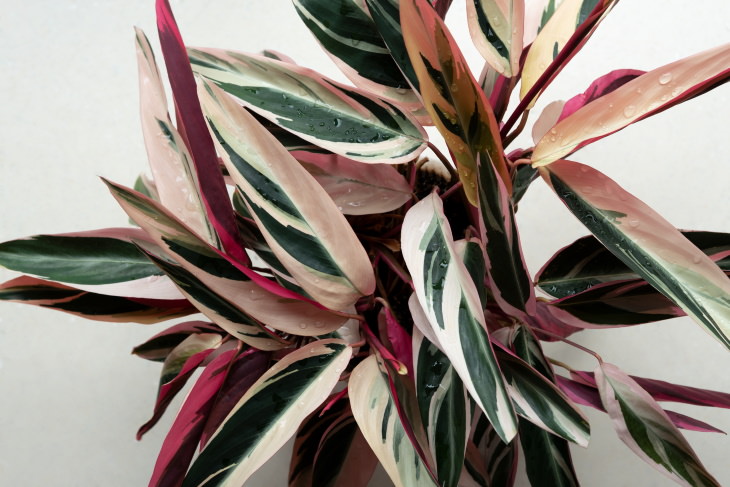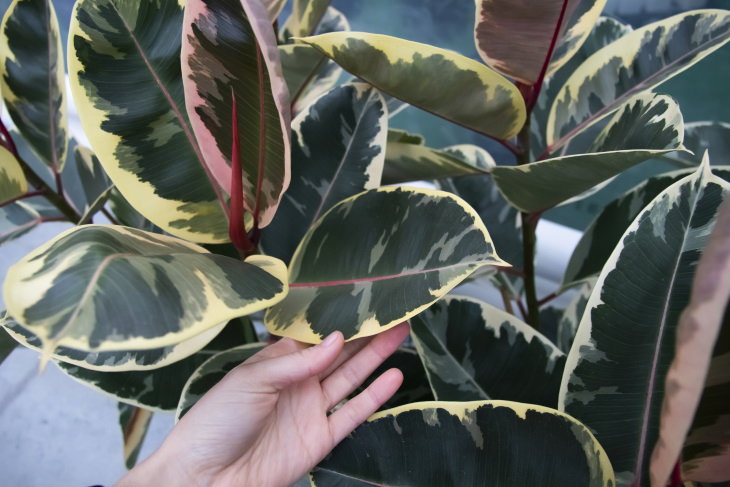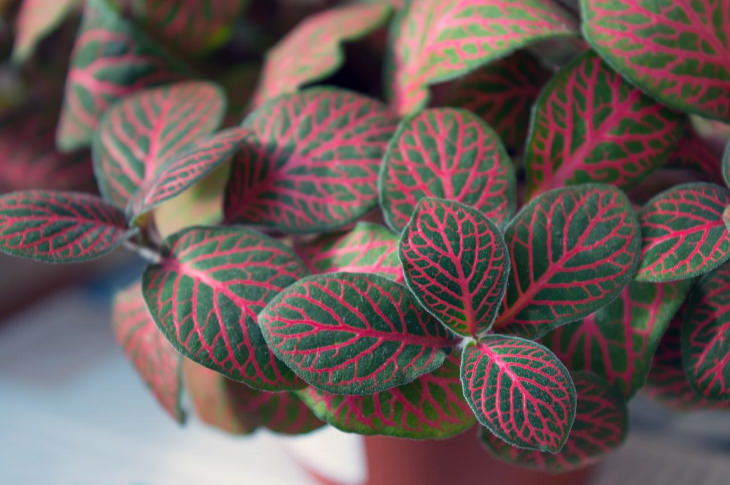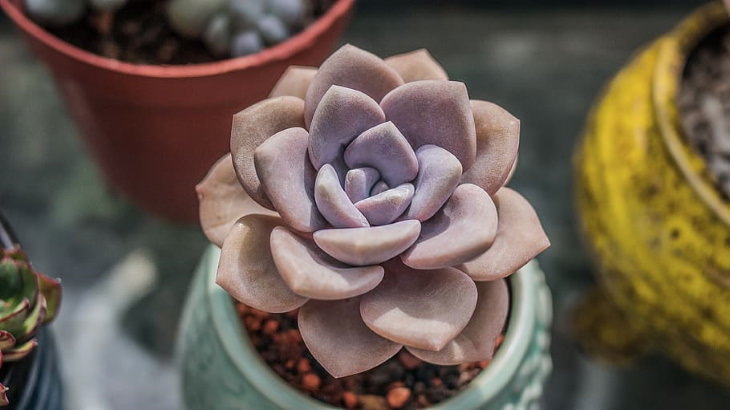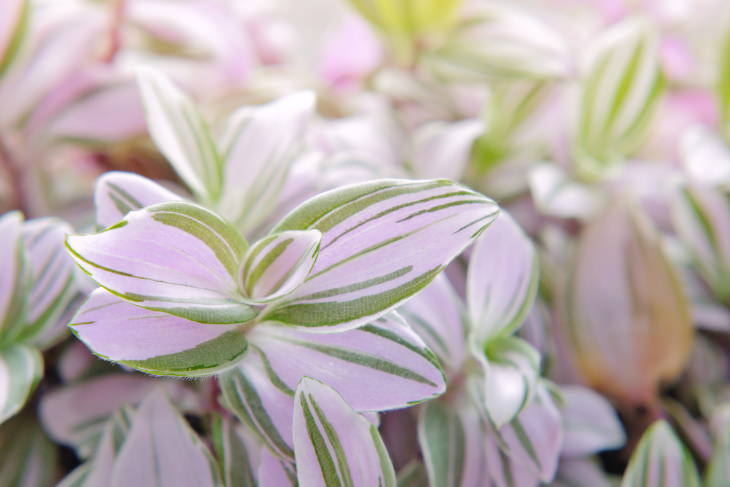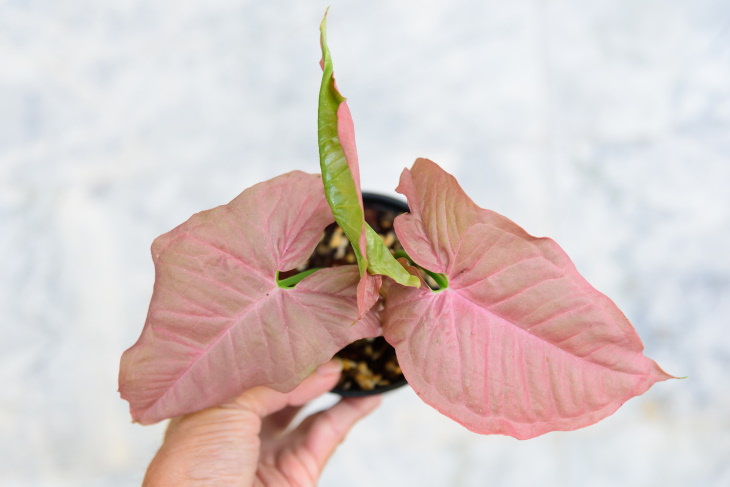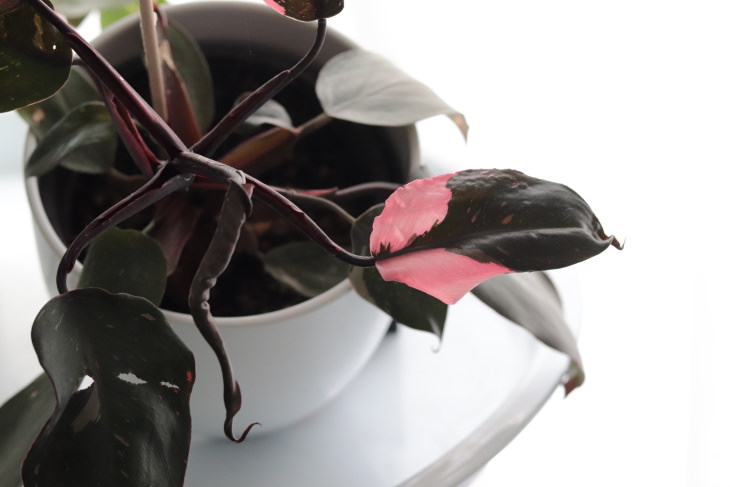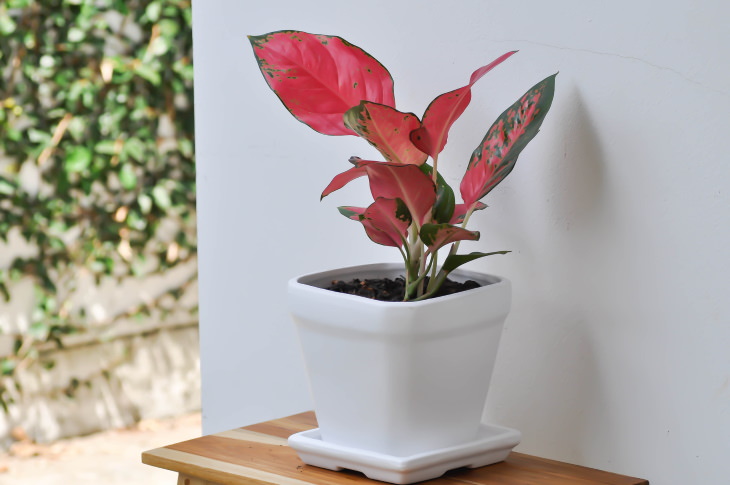Stromanthe Triostar (Stromanthe sanguinea)
Natural variegation, or the appearance of different colors in the leaves and stems in plants, is rather common in plants. Without any doubt, Stromanthe Triostar is one of the finest examples of this stunning property of plants. Every leaf has a unique mix of pink, white, and dark green from the stem to the tip, which makes it appear like a different plant from various points of view.
Stromathes are native to the tropical rainforest, so they require constantly damp soil, bright indirect light, and high humidity.
Pink Rubber Tree (Ficus elastica)
Who needs a pink flower if you could have a tall pinkish tree? The rubber tree is well-known because it is highly tolerant of varying light conditions, requires little watering, and doesn’t require a lot of care. The large and beautiful glossy leaves of the common rubber tree are dark green, but this variegated variety is a mixture of pink, red, yellow, and different shades of green.
The more light you give this pretty plant, the more colorful it will become.
Calathea Pinstripe (Calathea ornata)
The Calathea genus includes a wide range of plants cherished for their large ornamental leaves. Calatheas are also known as peacock plants for the intricate patterns and color combinations that adorn their leaves. They also go by the name ‘prayer plants’ because their leaves move with the light. Calathea Pinstripe has glossy dark green and purple leaves embellished with long pink stripes.
Calatheas are tropical plants that thrive in higher humidity environments and require meticulous watering. On the upside, Calathea Pinstripe can tolerate partial shade, so it makes an excellent bathroom plant, as long as you’ve got a window in the room.
Nerve Plant (Fittonia)
Fittonias are the unsung heroes of the houseplant world. These inexpensive miniature plants have colorful veining, which is why fittonias are also referred to as nerve plants. You can find these houseplants in a range of colors, including a few shades of pink. Our favorite pink cultivars are Fittonia albivenis 'Frankie' and Fittonia verschaffeltii 'Pink Angel.'
Give fittonias constant indirect light and water them regularly, especially when you see that their leaves drooping.
Echeveria
Echeverias are often called ‘stone roses,’ and once you lay your eyes on the pink rosettes of these beautiful succulents, you’ll instantly understand why. In our opinion, the two prettiest pink cultivars are Echeveria ‘Perle Von Nurnberg’ and Echeveria ‘Pink Champagne.’ Mature echeverias grow to be around 10 inches (25 cm) in diameter, and they have thick fleshy leaves covered by a pinkish white natural dusting that protects these succulents from sun rays.
Echeverias are related to cacti and require very similar growing conditions - bright direct light and very little water. If you’re growing these plants indoors, place them on the sunniest windowsill and be careful not to overwater.
Caladium
Caladiums come in a huge variety of color combinations and can be grown both indoors and outdoors. As for the pink varieties, the large heart-shaped leaves can either look completely pink or have green leaves with a splash of pink.
Caladium leaves are very thin and delicate, so you don’t want to keep them in direct sunlight. Otherwise, the plant will develop crispy brown tips. Caladium doesn’t mind drying out a bit in-between watering, so make sure that the top few inches of the soil dry out before you water this houseplant.
Tradescantia
Tradescantias are famously easy to care for; they grow rather quickly, tolerate a varying amount of light, and require little watering. Not all tradescantias have pink leaves, but cultivars like Tradescantia blossfeldiana 'Bubblegum,' Tradescantia fluminensis 'Tricolor,' and Tradescantia pallida 'Pink Stripes' all come in vibrant shades of pink.
Arrowhead Plant (Syngonium podophyllum)
If you’re looking for a soft pink houseplant that can tolerate a variety of light conditions, a pink Syngonium is one of the best choices. The large arrowhead-shaped leaves of this plant are somewhat similar to Caladium, but Syngoniums are generally less finicky to have in the house because they don’t require a lot of water.
That being said, it’s best to keep your pink Syngonium closer to a window if you want to maintain the bright pink coloring of the leaves.
Pink Jelly Bean (Sedum rubrotinctum ‘Aurora’)
The cute name is not the only reason why this succulent made this list. When exposed to bright light, the plump spiraling leaves of this houseplant turn entirely pink. Like most succulents, the Pink Jelly Bean is a rather small drought-tolerant plant that requires plenty of sunlight.
Pink Princess (Philodendron erubescens 'Pink Princess')
The Pink Princess is one of the most popular albeit expensive houseplants on this list. The variegated philodendron has large dark green, almost black leaves with soft pink sections. Like most philodendrons, Pink Princess philodendrons are fast growers, and they’re rather easy to care for too. These houseplants grow the best in bright indirect light and require well-draining soil.
Aglaonema 'Lady Valentine' (Aglaonema)
Aglaonemas are becoming increasingly popular these days, and it’s easy to see why considering their colorful leaves and intricate leaf patterns. These houseplants are often compared to Calatheas in terms of their stunning variegation, but Aglaonemas are much easier to care for.
These houseplants grow fast and are flexible in terms of lighting and watering. Among most Aglaonemas, 'Lady Valentine' is a real stand-out. It has large green leaves with large sections of bright pink.
Share these beautiful houseplants with those who love the color pink

